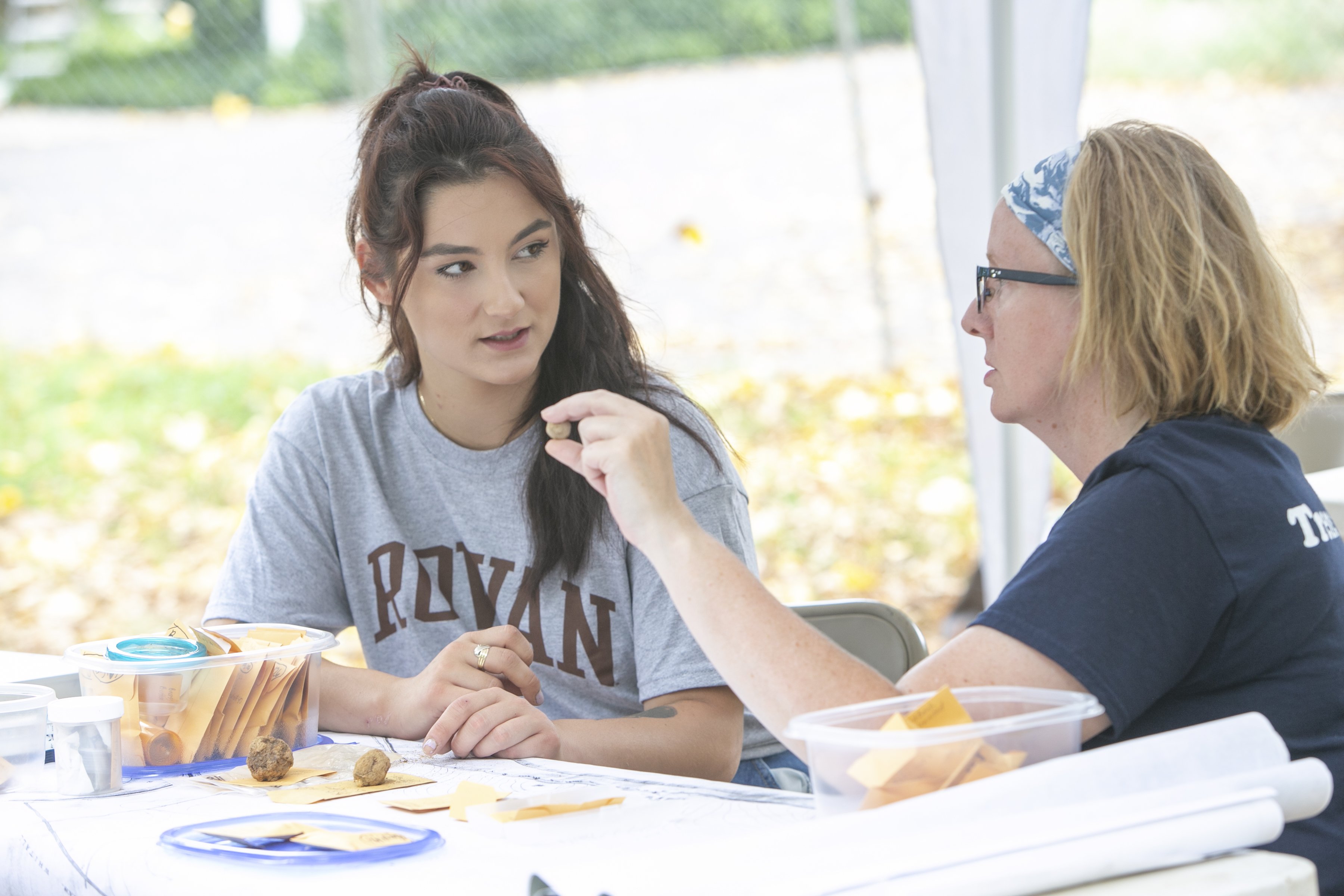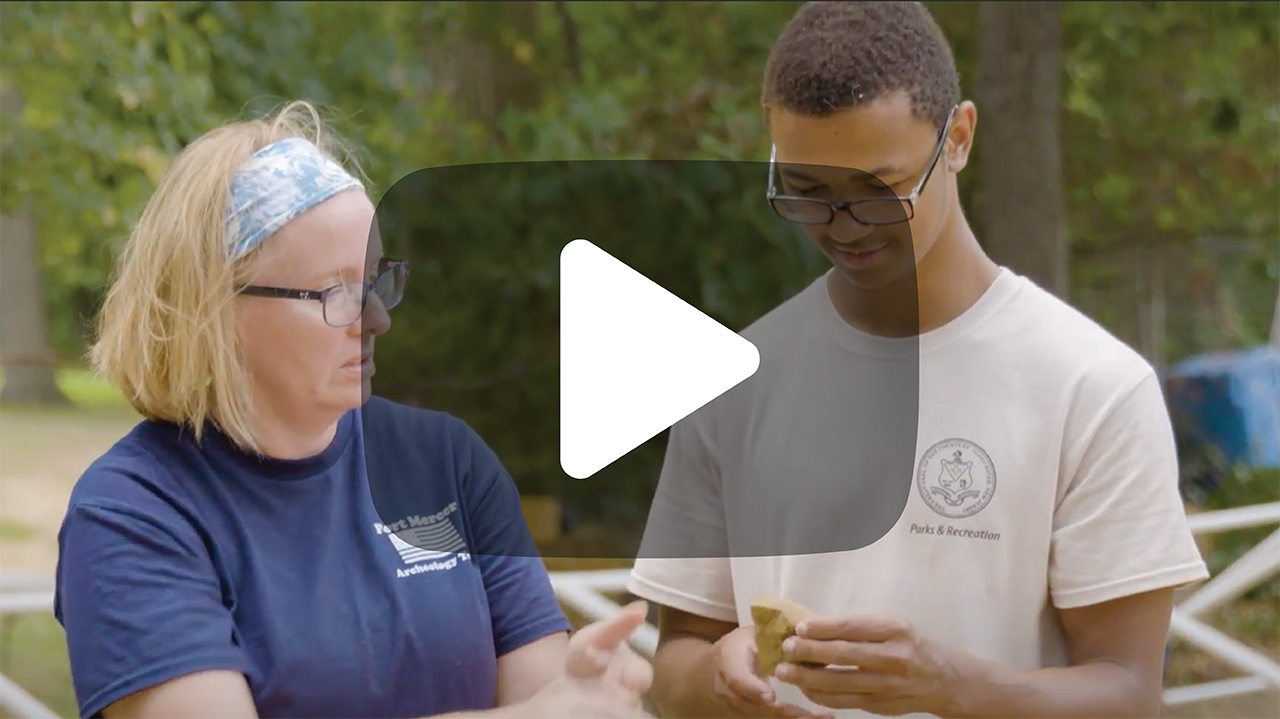Professor details stunning battlefield discoveries: 245 years after battle, soldiers' remains uncovered at Red Bank
Professor details stunning battlefield discoveries: 245 years after battle, soldiers' remains uncovered at Red Bank

The big find was a nearly pristine—and extremely rare—1766 King George III gold guinea.
And then someone uncovered a human femur.
“One of our volunteers who was digging said, ‘I think I have a bone.’ And…everything…stopped,” says Rowan University historian Jennifer Janofsky, director of Red Bank Battlefield Park in National Park.
“I’ll never forget that moment. It was stunning. It was overwhelming. It was sad.”
 Altogether, in fact, the skeletal remains of approximately 13 individuals, believed by researchers to be Hessian soldiers, were uncovered this summer during an archaeological dig at the battlefield—the site of what Janofsky says was the greatest upset victory of the American Revolution.
Altogether, in fact, the skeletal remains of approximately 13 individuals, believed by researchers to be Hessian soldiers, were uncovered this summer during an archaeological dig at the battlefield—the site of what Janofsky says was the greatest upset victory of the American Revolution.
Buried for 245 years just four and a half feet deep, the remains—femurs, skulls, teeth—were found in a mass grave, a rarity for Revolutionary War battle sites, according to Janofsky, the Megan Giordano Fellow in Public History in Rowan’s College of Humanities & Social Sciences.
“As we removed more remains, it became clear to us that this was not one individual. We were looking at a mass grave and, in all likelihood, a Hessian mass grave.
“Finding battlefield remains is incredibly unusual,” continues Janofsky, who secured a $19,000 New Jersey Historical Commission grant to conduct four public digs this summer on a quarter-acre parcel of land adjacent to the existing park that was purchased by Gloucester County last summer because of its historical significance. County officials committed $30,000 in additional funding for the archaeology project.
Battle of Red Bank
The parcel included part of a trench that surrounded Fort Mercer, a Revolutionary War installation at Red Bank. On Oct. 22, 1777, outnumbered-but-emboldened American defenders were victorious over Hessian soldiers fighting for the British Crown. The victory, Janofsky says, was the greatest upset of the American Revolution.
The Hessians, some 2,000 soldiers strong, suffered heavy casualties—approximately 377. The Americans, integrated regiments of Black and white soldiers fighting for freedom side by side, numbered 500. Fourteen Americans were killed. The battle was a key defense for Americans to delay the British from advancing supplies up the Delaware River to Philadelphia.
The fort was destroyed in November of 1777 when the Americans abandoned it.
Public digs, significant discoveries
This summer, during four public digs ending June 26, more than 100 members of the public shoveled dirt and screened and washed artifacts as they learned about archaeology. Toward the end of the dig, significant finds were unearthed, including the gold guinea (the equivalent of one month’s pay for a soldier), musket balls, grapeshot, canister shot, and a uniform knee buckle, which researchers later determined contained uniform fibers and human blood.
“The public was here when the coin came up through one of the screens,” Janofsky says. “And the shouts and the excitement—to see it, to hold it. It was an amazing moment.”
But the discovery of the human remains took the dig in a direction no one expected. In historical maps, there was no indication that the site contained a mass grave, Janofsky says.
“We didn’t anticipate exhuming human remains. That was not the goal of this,” Janofsky says.
Learn more about the project and view photos at Rowan View.
Confirming human remains, preparing for DNA analysis
When the femur was discovered, Janofsky made a flurry of phone calls—to the county, to the medical examiner, to local and state police. New Jersey State Police Forensic Anthropologist Anna Delaney visited the site and confirmed the femur was from a human. Additional digging by archeologists from South River Heritage Consulting, led by president/principal archaeologist Wade Catts, meticulously, reverently uncovered additional remains.
Based on the artifacts found with the remains, researchers believe the remains are Hessian soldiers. But additional study is needed to confirm that, according to Janofsky and Catts.
“We’re assuming they’re Hessian soldiers based on everything we’ve found, the context of what we’ve found, and the artifacts and objects that are in place with them.
“This is very much a death scene investigation,” says Catts. “It’s a really significant archaeological site.”
All remains were excavated and turned over to the NJSP Forensic Unit. There, forensic anthropologists are extracting DNA from the bones and teeth to identify their origin.
Skeletal assessment, isotopic, genetic and radiological analyses also are ongoing to provide in-depth analysis of the human remains and to gather biological data and indicators of life history, health and disease, and other factors.
DNA analysis, including from the knee buckle containing blood, as well as musket balls that may have come in contact with bodies during battle, also may help the team to identify the remains…and even eventually find descendants of those who lost their lives on the battlefield.
“We have real potential to be able to gain information and try to match that up through genetic DNA or genealogical DNA,” says Catts. “It’s an opportunity to try to get a sense of closure for something that many families don’t even know they need.”
The DNA investigation will be led by Delaney.
Personal stories of the horror of war
Understanding the personal stories of the dead—and the impact their loss had on future generations—helps tell of the battle and the very personal cost of war, says Janofsky.
“We’re hoping that eventually, perhaps, we can find some of these individuals,” says Janofsky. “If we can extract their stories, and if we can tell their stories, it lets us put a name to a face. And that, to me, is a very powerful moment in public history.”
Equally powerful, Janofsky says, is that the public and her Rowan students have been intimately involved in the discovery. The discovery was announced publicly during a press event on August 2.
“What makes this project so compelling is the public participation,” says Janofsky. “It wasn’t just a straight archaeology projects. We incorporated over 100 volunteers to help us move soil. Literally hundreds of hours were committed in volunteer service to this project.
“Working with the public and getting them excited about the historical process is my goal. To have people hold history—raw historical material--in their hands is an absolutely transformative moment. You can see the electricity. You can see the connection with past, particularly for young families.”
Looking out at the 44-acre battlefield site, the lives lost in battle is never far from Janofsky’s mind. With the discovery of the remains—researchers believe they include the bones of at least one young man between the ages of 17 and 19—the sadness and brutality of the war is ever present.
When the study of the remains is complete, they eventually will be reinterred at another site. The trench eventually will be refilled and the land will be incorporated into the park.
The site gives Janofsky and other historians the chance to offer the public a more nuanced understanding of the park’s historical significance, the Battle of Red Bank, and the sacrifices soldiers on both sides made.
“Yes, this is an amazing victory for American forces, but the loss of life is really about the brutality of war,” says Janofsky. “We now have the opportunity to work with our visitors to understand the emotion, pain, loss—and absolute horror—of war.”